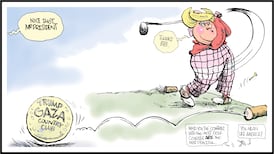ON THE ADJOURNMENT With the Dáil and Seanad in recess, and Drapier on holidays, backbenchers have their chance to sound off. This week: Senator Cyprian Brady on the changing face and confidence of Sheriff Street and the North Wall in Dublin
One of my earliest memories of Sheriff Street is being dragged in off the street to my grandmother's house because a bull had broken loose on Johnny Cullen's Hill and was charging over the bridge. Another early memory is the strong, spicy smell of the port and wine from the bonded warehouses under the dark, damp railway arches in Seville Place. The smell is long gone, and the only cattle passing through the area now are in the backs of super-trucks.
The transformation of this area is probably the most startling and striking in the whole country. When the flats (Phil Shanahan House, St Brigid's Gardens, St Laurence's Mansions etc) started to come down in the early 1980s it was the beginning of a long journey, parts of which continue today.
For years the North Wall was tagged as a "no-go" area (similar to Ballymun and parts of Tallaght). In a community ravaged by unemployment, drug abuse, bad housing and anti-social behaviour in the 1970s and 1980s, a spirit of hope and strength prevailed (mainly promoted by the older residents), and a sense of community spirit is still alive and kicking despite the problems. And there are still problems.
However, a dedicated core of North Wallers continue to raise the difficult issues. From damp, decrepit flats to own-front-door housing; from drug-dealing and joyriding on the tarmac "football pitch" to the FÁS Community Training Workshop and the North Wall Women's Centre and Crèche; from drinking cans in the stairwells to the yearly black-tie ball in Sheriff United sports hall, or taking part in the Dublin Docklands Talent competition; these are the changes that only the locals see.
As with almost everything, the key to most problems is education. After many years struggling in one of the most socially deprived areas in the country, and following the wane in the participation of the Christian Brothers and the nuns, finally some investment in the educational facilities has had, and will continue to have, a huge effect on this area.
Some of the services (teachers, the clergy, some health board workers, Dublin City Council staff and some gardaí) never gave up on the place or the people. Some residents took risks and, sometimes at great personal expense, took on the small minority of bad apples who had given the area a bad name. It was always a tough, working-class community.
There were very hard times in the 1940s, 1950s and 1960s, but most people kept themselves and their families going by sheer hard graft and determination.
There was sometimes a need to bend the rules, to survive by guile and cunning; but it was only a few who crossed the line into criminality. The vast majority worked hard and indeed played hard. You only have to look at the supply of talented musicians, sportsmen and women, business people and writers who have gone on to make it in the "real world" outside.
This transformation didn't take place by accident. To listen to some commentators you would imagine that areas like the North Wall have gone nowhere fast in the last number of years. This is just not true. Fianna Fáil, working in close partnership with the local communities, recognised a long time ago that these areas had been badly neglected, and indeed ignored, for too long.
By an agreed long-term programme of investment in education (mainstream and special education), housing, leisure and childcare facilities and drug treatment and rehabilitation services, the North Wall and other areas of the city were given the opportunity to change. And the people grabbed that opportunity with both hands.
The regeneration of the Docklands area continues to be one of the most exciting and ambitious projects in Europe, and the people of the North Wall have played their part in this. If one of the many dockers, stevedores or cattle-drovers who lived there in a bygone era came back today, they would hardly recognise the modern, cosmopolitan, bustling streets of what for many years was a wasteland.
The Wall always had an exotic element to it because of its proximity to Dublin Port, and I remember being told the story of how the families in the area were the only ones to be able to put their hands on bananas and oranges during the last World War. They might not have had bread or milk, but they knew what a coconut was!
Times have changed, but the spirit of neighbourliness and the willingness to share one's own good fortune continues today in communities such as the North Wall.
Down through the generations these values have been passed on but, because of the circumstances, there continues to be a small element that slips through the net. However, the State agencies, working closely with community activists and the public representatives, continue to invest time and resources in all areas of life in this community and throughout the city and beyond.
When a kid from the North Wall walks down the quays now and sees the huge office blocks, the banks and the expensive apartments they no longer say: "Why have they got everything?" They can say: "Someday I'll work there" or "I'll live in one of those apartments". You can see the difference in the children: they are more confident; they talk more and they ask more questions.
There is still some way to go but this area has changed and continues to change for the better. Sometimes we are slow to recognise progress and to give credit where it's due. The people of the North Wall deserve that credit, and long may their progress continue.
Cyprian Brady is a Fianna Fail senator.
Next week: John Deasy of Fine Gael







